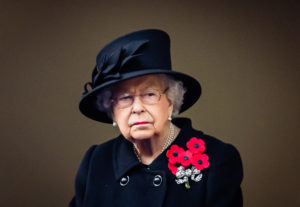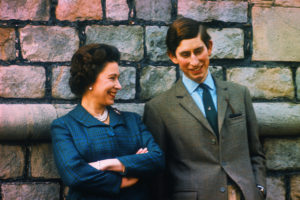Edward VII was the first monarch to lie in state in Westminster Hall. Half a million people queued up to see the King over those three days in May 1910, many of them in the rain. Our late Queen will have double that; some bowing, some kneeling, some crossing themselves with a prayer. Edward VII’s funeral was also the first time that Big Ben sounded for this occasion, a gong for each year of the monarch’s life. He was fond of his claret and smoked 20 a day, so the bell didn’t toll as many times as it did for Elizabeth.
But, for all these innovations, the most culturally influential thing that happened over that long weekend was probably a sermon preached over at St Paul’s Cathedral by Canon Henry Scott Holland.
You will know the words. I know them by heart, having used them countless times at the crematorium. They still constitute one of the most requested texts at funerals. Yet few people are aware that they are taken from a sermon. Rarely can a text have been so butchered in interpretation. Taken out of context and written in swirly script on saccharine condolence cards, one sentence per line, as if it were a poem, this text came to be presented as meaning almost the opposite of what was intended:
“Death is nothing at all. I have only slipped away into the next room. I am I, and you are you, … whatever we were to each other, that we are still.”
Within a decade, millions of men would die in the trenches of northern France. Later, six million would be murdered in the Holocaust, and be slaughtered with the development of new weapons of war including the nuclear bomb. How could they keep on reading out “death is nothing at all”? What a ridiculous thing to say.
Yet the second half of the 20th century — perhaps because of the horror of the first half — ended up being the “death is nothing at all” era. Many people stopped wearing black at funerals. Guests were invited to wear something colourful to celebrate a life. “I don’t want people to be sad” is the thing I hear most often from the dying.
Most people of the post-war generation never saw a dead body, still less touched one. Whereas Victorians gathered around the bedside of their dying relatives, after the war, people started more and more to die, not at home, but in hospitals surrounded by bleeping equipment and medical professionals. The curtains came to be drawn around death. We protected our children from it. We told our dying relatives that they were going to get better. Then at the funeral we all smiled, played upbeat songs and said death wasn’t real. Death was eliminated from the public square.
It is crazy that a sermon preached on the occasion of the King lying in state could have come to express and propagate this sentiment because it is certainly not what Scott Holland meant at all. Here, for instance, is a latter bit of the same sermon:
“White light breaks itself against the blackness of a closed coffin, flung up before the eyes of all, to embody the irreparable disaster of a death which has touched the very heart of our National life… Is this all that is left? Is this the end of that royal splendour of life? Ah, then death is a dreadful thing. It is blind. It is dumb.”
It’s not all that hard to see how the mistake was made. Holland was a Hegelian, and in typically Hegelian fashion he was doing a bit of dialectical thinking from the pulpit. “I suppose all of us hover between two ways of regarding death” is the opening line of his sermon. He then goes on to express these two ways. First the “all is vanity” approach: “It makes everything we do here meaningless and empty.” This is the thesis. Next comes the antithesis, which is the “death is nothing at all” bit. Finally, comes the synthesis – and I will come to that. The Scott Holland “poem” is thus only one side of the equation. What is absent is the cold dark emptiness of loss.
The Queen’s funeral will have little of “death is nothing at all” sentimentality about it. It will be properly serious, sombre, and mournful. The King of Terrors, as Holland titled his sermon, will have his due. The liturgy for the Queen will be from the Book of Common prayer. Reassuringly old-fashioned with the words of scripture magnificently vested in 17th century prose: “Man that is born of woman hath but a short time to live, and is full of misery. He cometh up, and is cut down; he fleeth as it were a shadow, and never continueth in one stay.” These are sentiments for ashen faces and broken hearts.
Like all proper Christian funerals, it expresses unambiguously that death is real. We are mortal creatures and we die. “As in Adam all die.” No qualification. God alone is immortal. Yet “so too in Christ shall all be made alive”. This is 1 Corinthians 15, and where thesis and antithesis come together gesturing — perhaps no more — towards some magnificent culmination, some synthesis where both death and life are true. Death and resurrection. It will be the first lesson of today’s service.
The extraordinary thing about the Queen’s funeral is that, when you strip away the fact that the congregation is full of monarchs and presidents, that it is in Westminster Abbey, and the sermon is by the Archbishop of Canterbury, what is being said here, and the form of liturgy that is being used is remarkably ordinary; in fact, very similar to the prayers and form of service that I use week in week out at the local crem. At its core, there is a democracy in death.
Her funeral will not be too long — the Queen hated long services — and it will be to the point. It will be dignified and unfussy. Away with the showy individualism of “I did it my way”, once the most popular song at funerals. The reason so many of us love the late Queen is precisely because she didn’t do it “my way”. The weight of vocation fell upon her shoulders, unbidden, unchosen. No wonder she chose The Lord’s my Shepherd, the 23rd Psalm, as one of the hymns for her funeral. “My head thou dost with oil anoint,” the congregation will sing, reminding us all of the coronation anointing, and of the promise the Queen made to serve both Christ and nation. It is indeed a pretty high calling. As the Dean of Westminster will say in his bidding prayer:
“Here, where Queen Elizabeth was married and crowned, we gather from across the nation, from the Commonwealth, and from the nations of the world, to mourn our loss, to remember her long life of selfless service, and in sure confidence to commit her to the mercy of God… With gratitude we remember her unswerving commitment to a high calling over so many years.”
The final hymn of today’s service speaks of us casting “our crowns before thee”. The Queen has finally fulfilled her promise and laid down her office. Monarchy comes to an end. Only the king of kings prevails forever.
Disclaimer
Some of the posts we share are controversial and we do not necessarily agree with them in the whole extend. Sometimes we agree with the content or part of it but we do not agree with the narration or language. Nevertheless we find them somehow interesting, valuable and/or informative or we share them, because we strongly believe in freedom of speech, free press and journalism. We strongly encourage you to have a critical approach to all the content, do your own research and analysis to build your own opinion.
We would be glad to have your feedback.
Source: UnHerd Read the original article here: https://unherd.com/



